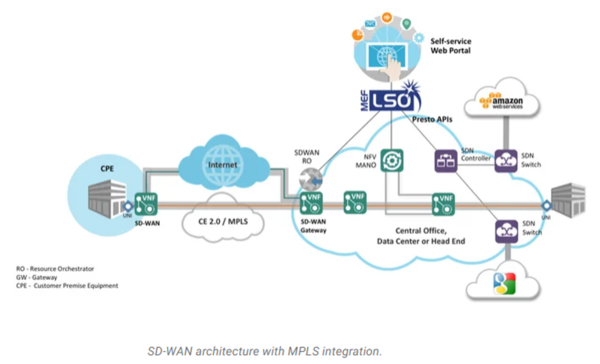Difference between revisions of "Software-Defined WAN (SD-WAN)"
(Created page with "'''Content Coming Soon'''") |
|||
| Line 1: | Line 1: | ||
| − | ''' | + | A '''Software-Defined Wide Area Network (SD-WAN)''' is a virtual [[Wide Area Network (WAN)|WAN]] architecture that allows enterprises to leverage any combination of transport services – including MPLS, LTE and broadband internet services – to securely connect users to [[Application|applications]]. An SD-WAN uses a centralized control function to securely and intelligently direct traffic across the WAN. This increases application performance, resulting in [[User Experience Design (UX)|enhanced user experience]], increased business productivity and reduced costs for [[Information Technology (IT)|IT]].<ref>Definition - What Does Software-Defined WAN (SD-WAN) Mean? [https://www.silver-peak.com/sd-wan/sd-wan-explained Silver Peak]</ref> |
| + | |||
| + | |||
| + | '''SD-WAN Architecture<ref>SD-WAN Architecture [https://www.sdxcentral.com/networking/sd-wan/definitions/software-defined-sdn-wan/ SDX Central]</ref>'''<br /> | ||
| + | SD-WAN uses an abstracted architecture for its [[Network|network]]. In an abstracted architecture, the network is divided into two parts: the control plane and the forwarding plane. This architecture moves the control plane to a centralized location like an organization’s headquarters. That way, the network can be managed remotely without the need for an on-premises IT crew. | ||
| + | |||
| + | |||
| + | [[File:SD-WAN_Architecture.png|600px|SD-WAN Architecture]]<br /> | ||
| + | source: SDX Central | ||
| + | |||
| + | |||
| + | There are three main components to an SD-WAN: The SD-WAN edge, the controller, and the orchestrator. | ||
| + | *The SD-WAN edge is where the network endpoints reside. This can be a branch office, a remote data center, or cloud platform. | ||
| + | *An SD-WAN Orchestrator is the virtualized manager for network, overseeing traffic and applying policy and protocol set by operators. | ||
| + | *The SD-WAN Controller centralizes management, and enables operators to see the network through a single pane of glass, and set policy for the orchestrator to execute. | ||
| + | These components make up the basic structure of an SD-WAN. In addition, there are three main types of SD-WAN architecture: on-premises, cloud-enabled, and cloud-enabled with a backbone. | ||
| + | *An On-premises SD-WAN is where the SD-WAN hardware resides on-site. Network operators can directly access and manage the network and the hardware it resides on, and it does not use the cloud for its connections. This makes making it ideal for sensitive information that cannot be sent over the internet. | ||
| + | *Cloud-enabled SD-WANs connect to a virtual cloud gateway over the internet, which makes the network more accessible, and provides better integration and performance with cloud-native applications. | ||
| + | *Cloud-Enabled with Backbone SD-WANs give organizations an extra backup by connecting the network with a nearby point of presence (PoP), such as within a data center. It allows an SD-WAN to switch from public internet to a private connection, which adds an extra layer of security and consistency in case the connection is overwhelmed or fails. | ||
Revision as of 21:53, 20 April 2020
A Software-Defined Wide Area Network (SD-WAN) is a virtual WAN architecture that allows enterprises to leverage any combination of transport services – including MPLS, LTE and broadband internet services – to securely connect users to applications. An SD-WAN uses a centralized control function to securely and intelligently direct traffic across the WAN. This increases application performance, resulting in enhanced user experience, increased business productivity and reduced costs for IT.[1]
SD-WAN Architecture[2]
SD-WAN uses an abstracted architecture for its network. In an abstracted architecture, the network is divided into two parts: the control plane and the forwarding plane. This architecture moves the control plane to a centralized location like an organization’s headquarters. That way, the network can be managed remotely without the need for an on-premises IT crew.
There are three main components to an SD-WAN: The SD-WAN edge, the controller, and the orchestrator.
- The SD-WAN edge is where the network endpoints reside. This can be a branch office, a remote data center, or cloud platform.
- An SD-WAN Orchestrator is the virtualized manager for network, overseeing traffic and applying policy and protocol set by operators.
- The SD-WAN Controller centralizes management, and enables operators to see the network through a single pane of glass, and set policy for the orchestrator to execute.
These components make up the basic structure of an SD-WAN. In addition, there are three main types of SD-WAN architecture: on-premises, cloud-enabled, and cloud-enabled with a backbone.
- An On-premises SD-WAN is where the SD-WAN hardware resides on-site. Network operators can directly access and manage the network and the hardware it resides on, and it does not use the cloud for its connections. This makes making it ideal for sensitive information that cannot be sent over the internet.
- Cloud-enabled SD-WANs connect to a virtual cloud gateway over the internet, which makes the network more accessible, and provides better integration and performance with cloud-native applications.
- Cloud-Enabled with Backbone SD-WANs give organizations an extra backup by connecting the network with a nearby point of presence (PoP), such as within a data center. It allows an SD-WAN to switch from public internet to a private connection, which adds an extra layer of security and consistency in case the connection is overwhelmed or fails.
- ↑ Definition - What Does Software-Defined WAN (SD-WAN) Mean? Silver Peak
- ↑ SD-WAN Architecture SDX Central

